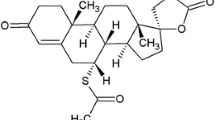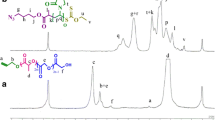Abstract
In this study, we report the synthesis of PDMAEMA-b-PCL-b-PDMAEMA via ATRP starting from two dibromide-end polycaprolactone (PCL) of 2 and 10 kDa. The copolymerization was confirmed by nuclear magnetic resonance and gel permeation chromatography. The micellar properties of copolymers with different compositions were studied at pH 5.0, 6.0, 7.0, and 7.5. According to results, properties such as critical micellar concentration (CMC), hydrophobicity of micelle cores, and particle size strongly depend on the length of PCL. The pH shows an important effect on the size of the colloidal aggregates. Micelles obtained from copolymers with the lowest polymerization degree of both segments showed to be more appropriate for the encapsulation of amphotericin B (AmB).








Similar content being viewed by others
References
Alexandridis P, Lindman B (2000) Amphiphilic block copolymers: self-assembly and applications. Elsevier
Torchilin VP (2001) Structure and design of polymeric surfactant-based drug delivery systems. J Control Release 73(2):137–172
Loh XJ, Wu YL, Joseph Seow WT, Irzuan Norimzan MN, Zhang Z-X, Xu FJ, Kang ET, Neoh KG, Li J (2008) Micellization and phase transition behavior of thermosensitive poly (N-isopropylacrylamide)–poly(ε-caprolactone)–poly(N-isopropylacrylamide) triblock copolymers. Polymer 49(23):5084–5094. doi:10.1016/j.polymer.2008.08.061
Yoon HJ, Jang WD (2010) Polymeric supramolecular systems for drug delivery. J Mater Chem 20(2):211–222
Kore G, Kolate A, Nej A, Misra A (2014) Polymeric micelle as multifunctional pharmaceutical carriers. J Nanosci Nanotechnol 14(1):288–307. doi:10.1166/jnn.2014.9021
Sinha V, Bansal K, Kaushik R, Kumria R, Trehan A (2004) Poly-ε-caprolactone microspheres and nanospheres: an overview. Int J Pharm 278(1):1–23
Nair LS, Laurencin CT (2007) Biodegradable polymers as biomaterials. Prog Polym Sci 32(8):762–798
Gaucher G, Dufresne MH, Sant VP, Kang N, Maysinger D, Leroux JC (2005) Block copolymer micelles: preparation, characterization and application in drug delivery. J Control Release 109(1):169–188
Burt HM, Zhang X, Toleikis P, Embree L, Hunter WL (1999) Development of copolymers of poly (d,l-lactide) and methoxypolyethylene glycol as micellar carriers of paclitaxel. Colloids Surf B: Biointerfaces 16(1):161–171
Shuai X, Ai H, Nasongkla N, Kim S, Gao J (2004) Micellar carriers based on block copolymers of poly (ε-caprolactone) and poly (ethylene glycol) for doxorubicin delivery. J Control Release 98(3):415–426
Aliabadi HM, Elhasi S, Mahmud A, Gulamhusein R, Mahdipoor P, Lavasanifar A (2007) Encapsulation of hydrophobic drugs in polymeric micelles through co-solvent evaporation: the effect of solvent composition on micellar properties and drug loading. Int J Pharm 329(1):158–165
Van de Wetering P, Cherng JY, Talsma H, Crommelin DJA, Hennink WE (1998) 2-(Dimethylamino)ethyl methacrylate based (co)polymers as gene transfer agents. J Control Release 53(1–3):145–153. doi:10.1016/S0168-3659(97)00248-4
Zhang W, He J, Liu Z, Ni P, Zhu X (2010) Biocompatible and pH‐responsive triblock copolymer mPEG‐b‐PCL‐b‐PDMAEMA: synthesis, self‐assembly, and application. J Polym Sci A Polym Chem 48(5):1079–1091
Xu FJ, Li H, Li J, Zhang Z, Kang ET, Neoh KG (2008) Pentablock copolymers of poly(ethylene glycol), poly((2-dimethyl amino)ethyl methacrylate) and poly(2-hydroxyethyl methacrylate) from consecutive atom transfer radical polymerizations for non-viral gene delivery. Biomaterials 29(20):3023–3033. doi:10.1016/j.biomaterials.2008.03.041
Zhu C, Jung S, Luo S, Meng F, Zhu X, Park TG, Zhong Z (2010) Co-delivery of siRNA and paclitaxel into cancer cells by biodegradable cationic micelles based on PDMAEMA–PCL–PDMAEMA triblock copolymers. Biomaterials 31(8):2408–2416
Xu F, Neoh K, Kang E (2009) Bioactive surfaces and biomaterials via atom transfer radical polymerization. Prog Polym Sci 34(8):719–761
Qian X, Long L, Shi Z, Liu C, Qiu M, Sheng J, Pu P, Yuan X, Ren Y, Kang C (2014) Star-branched amphiphilic PLA-b-PDMAEMA copolymers for co-delivery of miR-21 inhibitor and doxorubicin to treat glioma. Biomaterials 35(7):2322–2335. doi:10.1016/j.biomaterials.2013.11.039
Lee AS, Gast AP, Bütün V, Armes SP (1999) Characterizing the structure of pH dependent polyelectrolyte block copolymer micelles. Macromolecules 32(13):4302–4310
Baines F, Billingham N, Armes S (1996) Synthesis and solution properties of water-soluble hydrophilic-hydrophobic block copolymers. Macromolecules 29(10):3416–3420
Liu S, Weaver JV, Tang Y, Billingham NC, Armes SP, Tribe K (2002) Synthesis of shell cross-linked micelles with pH-responsive cores using ABC triblock copolymers. Macromolecules 35(16):6121–6131
Matyjaszewski K, Tsarevsky NV (2014) Macromolecular engineering by atom transfer radical polymerization. J Am Chem Soc 136(18):6513–6533. doi:10.1021/ja408069v
Ran J, Wu L, Zhang Z, Xu T (2014) Atom transfer radical polymerization (ATRP): a versatile and forceful tool for functional membranes. Prog Polym Sci 39(1):124–144. doi:10.1016/j.progpolymsci.2013.09.001
Guo S, Qiao Y, Wang W, He H, Deng L, Xing J, Xu J, Liang XJ, Dong A (2010) Polycaprolactone-graft-poly(2-(N,N-dimethylamino) ethyl methacrylate) nanoparticles: pH dependent thermo-sensitive multifunctional carriers for gene and drug delivery. J Mater Chem 20(33):6935–6941. doi:10.1039/C0JM00506A
Lin D, Jiang Q, Cheng Q, Huang Y, Huang P, Han S, Guo S, Liang Z, Dong A (2013) Polycation-detachable nanoparticles self-assembled from mPEG-PCL-g-SS-PDMAEMA for in vitro and in vivo siRNA delivery. Acta Biomater 9(8):7746–7757. doi:10.1016/j.actbio.2013.04.031
Yue X, Qiao Y, Qiao N, Guo S, Xing J, Deng L, Xu J, Dong A (2010) Amphiphilic methoxy poly (ethylene glycol)-b-poly(ε-caprolactone)-b-poly(2-dimethylaminoethyl methacrylate) cationic copolymer nanoparticles as a vector for gene and drug delivery. Biomacromolecules 11(9):2306–2312. doi:10.1021/bm100410m
Zhang Y, He J, Cao D, Zhang M, Ni P (2014) Galactosylated reduction and pH dual-responsive triblock terpolymer Gal-PEEP-a-PCL-ss-PDMAEMA: a multifunctional carrier for the targeted and simultaneous delivery of doxorubicin and DNA. Polym Chem 5(17):5124–5138. doi:10.1039/C4PY00538D
Han S, Wan H, Lin D, Guo S, Dong H, Zhang J, Deng L, Liu R, Tang H, Dong A (2014) Contribution of hydrophobic/hydrophilic modification on cationic chains of poly(ε-caprolactone)-graft-poly(dimethylamino ethylmethacrylate) amphiphilic co-polymer in gene delivery. Acta Biomater 10(2):670–679. doi:10.1016/j.actbio.2013.09.035
Lo YL, Chen GJ, Feng TH, Li MH, Wang LF (2014) Synthesis and characterization of S-PCL-PDMAEMA for co-delivery of pDNA and DOX. RSC Adv 4(22):11089–11098. doi:10.1039/C3RA46914J
Deray G (2002) Amphotericin B nephrotoxicity. J Antimicrob Chemother 49(suppl 1):37–41
Rao JP, Geckeler KE (2011) Polymer nanoparticles: preparation techniques and size-control parameters. Prog Polym Sci 36(7):887–913
Maiti S, Chatterji PR, Nisha C, Manorama S, Aswal VK, Goyal PS (2001) Aggregation and polymerization of PEG-based macromonomers with methacryloyl group as the only hydrophobic segment. J Colloid Interface Sci 240(2):630–635
Shim WS, Kim SW, Choi EK, Park HJ, Kim JS, Lee DS (2006) Novel pH sensitive block copolymer micelles for solvent free drug loading. Macromol Biosci 6(2):179–186
Motala-Timol S, Jhurry D (2007) Synthesis of PDMAEMA–PCL–PDMAEMA triblock copolymers. Eur Polym J 43(7):3042–3049
San Miguel V, Limer A, Haddleton DM, Catalina F, Peinado C (2008) Biodegradable and thermoresponsive micelles of triblock copolymers based on 2-(N,N-dimethylamino) ethyl methacrylate and ε-caprolactone for controlled drug delivery. Eur Polym J 44(11):3853–3863
Mok MM, Thiagarajan R, Flores M, Morse DC, Lodge TP (2012) Apparent critical micelle concentrations in block copolymer/ionic liquid solutions: remarkably weak dependence on solvophobic block molecular weight. Macromolecules 45(11):4818–4829
Li X, Mya KY, Ni X, He C, Leong KW, Li J (2006) Dynamic and static light scattering studies on self-aggregation behavior of biodegradable amphiphilic poly (ethylene oxide)-poly [(R)-3-hydroxybutyrate]-poly (ethylene oxide) triblock copolymers in aqueous solution. J Phys Chem B 110(12):5920–5926
Gohy JF (2005) Block copolymer micelles. In: Abetz V (ed) Block copolymers II, vol 190. Advances in polymer science. Springer, Berlin, pp 65–136. doi:10.1007/12_048
Wilhelm M, Zhao CL, Wang Y, Xu R, Winnik MA, Mura JL, Riess G, Croucher MD (1991) Poly (styrene-ethylene oxide) block copolymer micelle formation in water: a fluorescence probe study. Macromolecules 24(5):1033–1040. doi:10.1021/ma00005a010
Allcock HR, Cho SY, Steely LB (2006) New amphiphilic poly [bis(2,2,2-trifluoroethoxy)phosphazene]/poly(propylene glycol) triblock copolymers: synthesis and micellar characteristics. Macromolecules 39(24):8334–8338. doi:10.1021/ma061531w
Nicolai T, Colombani O, Chassenieux C (2010) Dynamic polymeric micelles versus frozen nanoparticles formed by block copolymers. Soft Matter 6(14):3111–3118. doi:10.1039/B925666K
Zamfir M, Patrickios CS, Montagne F, Abetz C, Abetz V, Oss-Ronen L, Talmon Y (2012) Styrene-vinyl pyridine diblock copolymers: synthesis by RAFT polymerization and self-assembly in solution and in the bulk. J Polym Sci A Polym Chem 50(8):1636–1644
Zhang X, Zhu X, Ke F, Ye L, EQ C, AY Z, ZG F (2009) Preparation and self-assembly of amphiphilic triblock copolymers with polyrotaxane as a middle block and their application as carrier for the controlled release of amphotericin B. Polymer 50(18):4343–4351
van de Wetering P, Zuidam NJ, van Steenbergen MJ, van der Houwen OAGJ, Underberg WJM, Hennink WE (1998) A mechanistic study of the hydrolytic stability of poly(2-(dimethylamino)ethyl methacrylate). Macromolecules 31(23):8063–8068. doi:10.1021/ma980689g
Chen WY, Alexandridis P, Su CK, Patrickios CS, Hertler WR, Hatton TA (1995) Effect of block size and sequence on the micellization of ABC triblock methacrylic polyampholytes. Macromolecules 28(25):8604–8611. doi:10.1021/ma00129a020
Tangeysh B, Fryd M, Ilies MA, Wayland BB (2012) Palladium metal nanoparticle size control through ion paired structures of [PdCl4]2− with protonated PDMAEMA. Chem Commun 48(71):8955–8957. doi:10.1039/C2CC34401G
Shim YH, Lee HJ, Dubois P, Chung CW, Jeong YI (2011) Amphotericin B aggregation inhibition with novel nanoparticles prepared with poly(ε-caprolactone)/poly(N,N-dimethylamino-2-ethyl methacrylate) diblock copolymer. J Microbiol Biotechnol 21(1):28–36
Acknowledgment
The authors thank the Pontificia Universidad Javeriana for financial support through grant number 5097.
Author information
Authors and Affiliations
Corresponding author
Rights and permissions
About this article
Cite this article
Diaz, I.L., Perez, L.D. Synthesis and micellization properties of triblock copolymers PDMAEMA-b-PCL-b-PDMAEMA and their applications in the fabrication of amphotericin B-loaded nanocontainers. Colloid Polym Sci 293, 913–923 (2015). https://doi.org/10.1007/s00396-014-3478-3
Received:
Revised:
Accepted:
Published:
Issue Date:
DOI: https://doi.org/10.1007/s00396-014-3478-3




